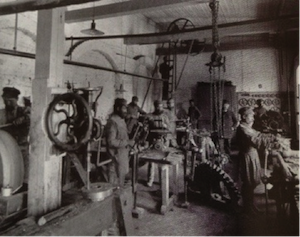

|
The Conditions of the Working Class  Typical engineering workshop, Moscow, 1890s Forced off the land, millions of peasants came into the towns, or worked in rural factories and mines. In the last half-century of the old regime the Empire's urban population grew from 7 to 28 million people. Factory conditions were terrible. According to Count Witte, the Finance Minister in charge of Russia's industrialization until 1905, the worker 'raised on the frugal habits of rural life' was 'much more easily satisfied' than his counterpart in Europe or North America, so that 'low wages appeared as a fortunate gift to Russian enterprise'. There was little factory legislation to protect labour. The two most important factory laws - one in 1885 prohibiting the night-time employment of women and children, and the other in 1897 restricting the working day to eleven and a half hours - had to be wrenched from the government. Small workshops were excluded from the legislation, although they probably employed the majority of the country's workforce, and certainly most of its female contingent. Shopfloors were crammed with dangerous machinery: there were frequent accidents. Yet most workers were denied a legal right to insurance and, if they lost an eye or limb, could expect no more than a few roubles' compensation. Workers' strikes were illegal. There were no legal trade unions until 1905. Many factory owners treated workers like their serfs. Russian workers were the most strike-prone in Europe during the 1900s. Three-quarters of the factory workforce went on strike in the revolutionary years of 1905-6. |
© 2014 Orlando Figes | All Rights Reserved